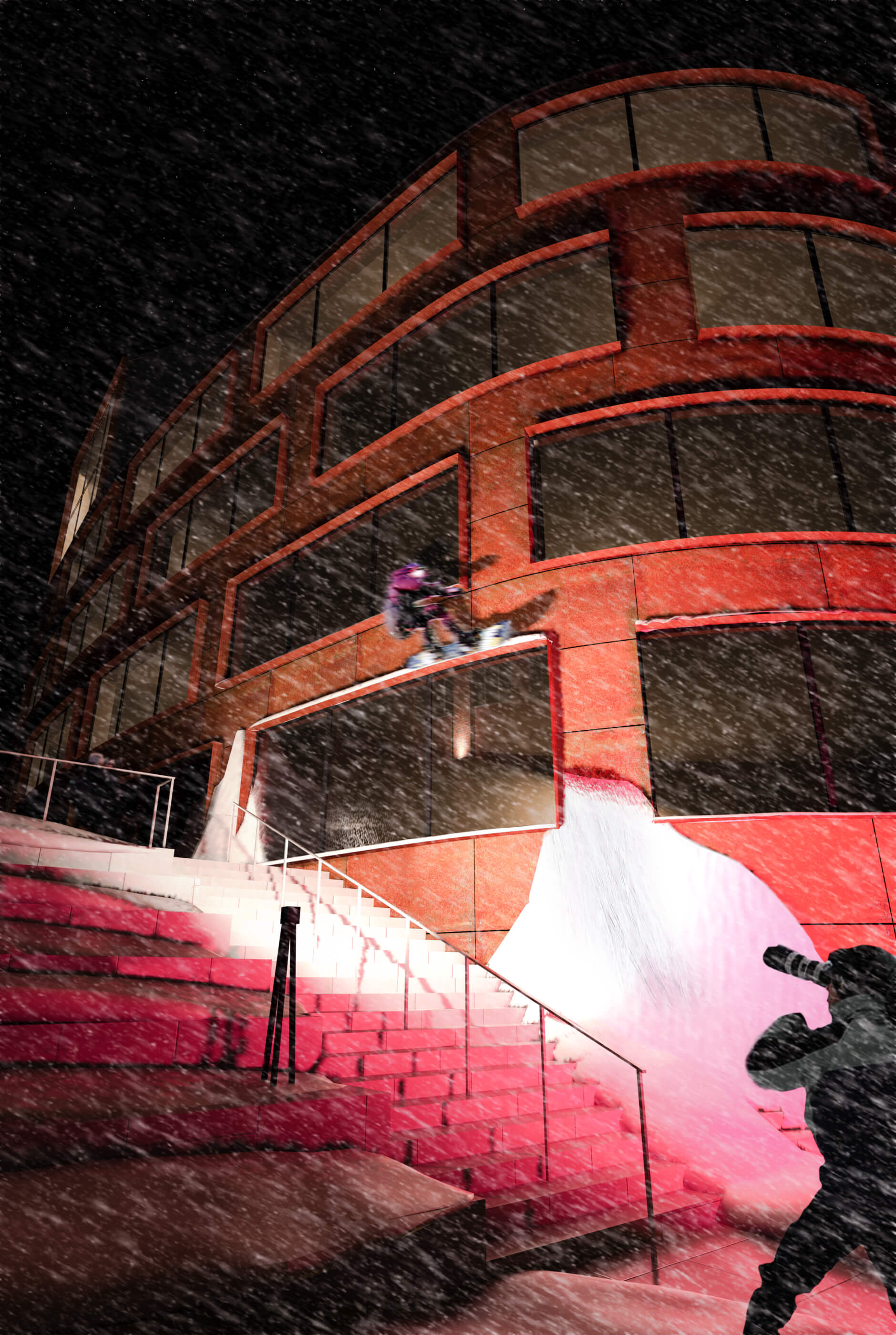My process is to first imagine one’s
narrative while inhabiting a space.
I observe materiality, character or space, location, program, and activity levels. Then I project unique perspectives from imagined characters that potentially would inhabit the space. What qualities the space has and what sort of mood an image should project are informed through this imagined walkabout.
Next I dig in to how someone might directly interact with the space and create a scene setting narrative. In this case is the character an architecture student walking to class carrying modeling supplies, or something a bit more intriguing? What time of day will daylight accentuate architectural tectonics, or project a certain mood? What is the weather? How might that interaction change or shape the experience a visitor has of the place?
For this challenge image I decided to explore though the eyes of a crew of friends visiting one evening to collect and experience urban snowboard footage.
This narrative informed me about nature of the activity for the image. An urban snowboarding photo shoot, the rider would be either directly interacting with the building or using the handrail as a less direct assault on the architecture. The activity would need to take place at night. One hundred percent artificial and controlled lighting. What color of lighting would best accent not only the snowboarder but play with the architecture to give the shot a heightened level of dramatics? I played around with blues, greens, and purples but a saturated pink fill light gave the scene a carnival atmosphere and complimented the warmth of the corten facade. The use of three spotlights positioned in a way that the snowboarder’s path would be illuminated and defined from approach, to maneuver, to landing. The spot lights being positioned accented the steel window frames that give this facade depth.
I enjoying poking at architecture and visualizations in this way. Drawing from my own experiences and projecting imagined ones onto a built or natural environment to better understand a place or a space. I grew up snowboarding in the mountains and foothills of Utah in the American West. My friends and I would always be looking for places to jump off of and park benches to slide on. This project has been a fantastic exercise of really examining the mechanics of a photo shoot set within a beautiful architectural setting. How people interact and shape the architecture, as unexpected as that may be, is where I think architecture gets its’ value. By thinking through the eyes of a person visiting or experiencing the space I can begin to create atmospheres and narratives that will then inform design decisions and create more compelling visuals. Images that when viewed display an atmosphere and give a viewer a feeling of what it means to be in the scene.
I had difficulties with the snow, getting it modeled and displayed took a few iterations. I had never attempted that before, but with the help of the internet I came to a solution. In addition the lighting and activity within the building kept presenting problems. Too much light and my eye was drawn away from the action. Too little and the composition suffered.
If I was to redo this project, I would focus on the detailed modeling of props, form a better understanding of where and how snow would stack up in a storm event, and perhaps include some activity within the building. Even if it was just a lone cleaning person going about their work as the action unfolded outside. It seems like every project is never truely finished. There is alway room for tweaks, and having presented and discussed this image with friends there are a range of suggestions or opinions about how to better represent my wishes. Reaching out to others was a great way to zoom out and refocus on elements I had missed. Working in a collaborative enviroment on a project like this would be fascinating and I imagine the final product would be much stronger with an office of minds and talent collaborating on a direction.
Thank you for the opportunity Tomorrow, and to Ronen Beckerman for really making this project visible. It has been a great process for personal growth and brought up some new and exciting problems to be solved. I hope that I might be able to bring my experience, passion to work and learn alongside the team at Tomorrow on many future projects.
Warm regards,
E.














